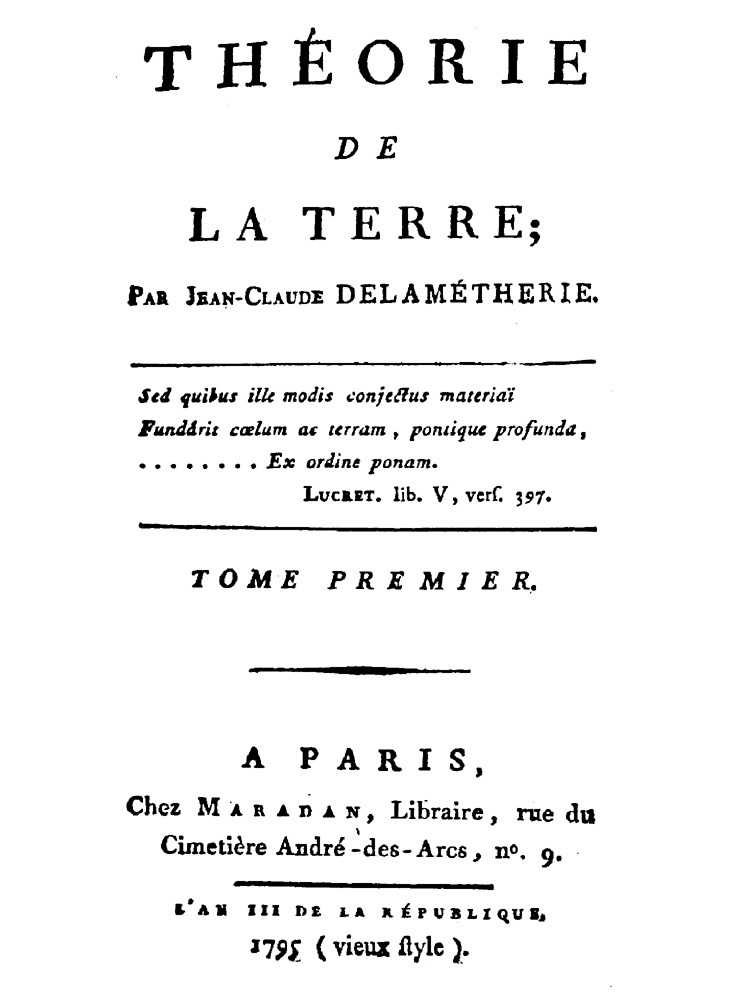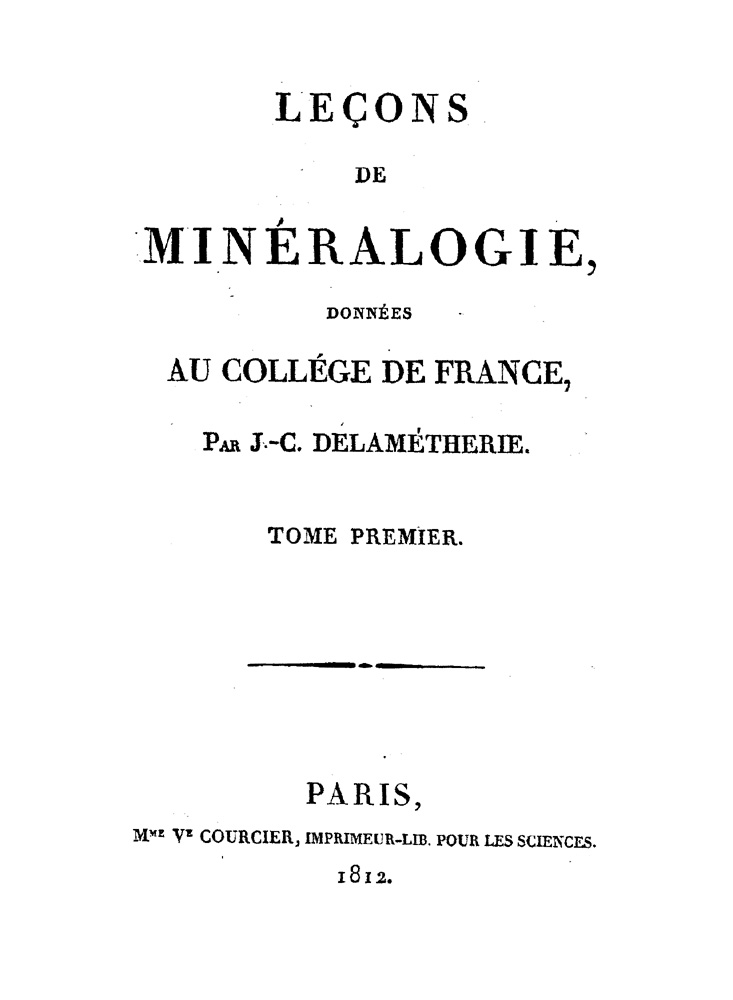DELAMéTHERIE, Jean-Claude.
(1743 – 1817)
Delamétherie was educated in medicine, but never practiced. From 1801 until his death he was professor of natural sciences at the Collège de France in Paris. In 1785, he became editor of the influential, Journal de Physique, a position he held until his death. He had a vivid imagination, which ruled his scientific thought.
Biographical references: Barr, Index to Biographical Fragments, 1973: 147. • Biographie Universelle: 28, 461-3 [by G. Cuvier]. • DSB: 7, 602-4 [by K.L. Taylor]. • Journal de Physique: 85 (1817), 78-107. • Kettner, Radim., "Jean André de Luc (1727, +1817) a Jean Claude de la Métherie (1743, +1817) a jejich teorie o Zemi", Casopis pro Mineralogii a Geologii, 12, (1967), no. 223-5. • Nouvelle Biographie Générale (Hoefer): 29, cols. 209-12. • Poggendorff: 1, cols. 1360-1. • Sarjeant, Geologists, 1980: 3, 1708. • Thomas, Dictionary of Biography, 1884: 1363. • World Who's Who in Science: 436.

1. French, 1795 [First edition].
Théorie | De | La Terre; | Par Jean-Claude Delamétherie. | [rule] | [...3 lines of quotation, signed "Lucret. lib. V, vers. 397.] | [rule] | Tome Premier. | [tapered rule] | A Paris, | Chez Maradan, Libraire, rue du | Cimetière André-des-Arcs, n°. 9. | [rule] | L'An III De La République. | 1795 (vieux style).
3 vols. [Vol 1] 8°: a8 A-Cc8 Dd3; 220l.; [i]-xvj, [1]-422, [2] p., 2 folding plates. [Vol 2] 8°: π4 A-Ee8 Ff4; 232l.; [i]-viij, [1]-456 p., 2 folding plates. [Vol 3] 8°: π4 A-Ff8 Gg4; 240l.; [i]-viij, [1]-471 p., 3 folding plates. Page size: 194 x 120 mm.
Contents: [Vol 1] [i-ii], Half title page, "Théorie | De | La Terre. | [rule] | Tome Premier. | [rule]," verso blank.; [iii-iv], Title page, verso blank.; v-xiij, "Introduction."; xiv-xvj, "Table Des Chapitres | Du Tome Premier."; [1]-422, Text.
[Vol 2] [i-ii], Half title page, "Théorie | De | La Terre. | [rule] | Tome Second. | [rule]," verso blank.; [iii-iv], Title page, verso blank.; [v]-vij, "Table Des Chapitres | Du Tome Second."; [1]-456, Text.
[Vol 3] [i-ii], Half title page, "Théorie | De | La Terre. | [rule] | Tome Troisieme. | [rule]," verso blank.; [iii-iv], Title page, verso blank.; [v]-vij, "Table Des Chapitres | Du Tome Troisieme."; [1]-471, Text.; [1 pg], Blank.
Very scarce. One of Delamétherie's major works, which enjoyed considerable popularity during his lifetime in spite of its ultra-Neptunian theories. Théorie de la Terre covers all aspects of the author's cosmological theory, with respect to the earth. A firm believer in Wernerian theory, he postulates that all things including living organisms were originally crystallized from a liquid medium. He also believed that the broad features of the earth's surface like mountains and ocean basins were caused by the action of irregular crystallizations deep with in the earth, moving water and the planetary motion of the earth. Erosion, he thought, played no significant role in geological history, and no major alterations to the crust had occurred since the main valleys and mountains were created by a primordial crystallization process. Despite these theories, Delamétherie had a wide influence among his contemporaries. If the refusal of the author to accept the significant role erosion plays in shaping the earth has lessened his reputation to historians of geology, he was innovative in his idea about evolution, speculating that man was a kind of monkey improved by social state.
The text of volume one is mostly mineralogical in character with discussions about the crystallization from fire of various substances, including the earths, airs, waters, ores, salts, stones, and precious stones. The general form of the earth is speculated on, as is the nature of electricity, magnetism, and light. Volume two could be considered an early volume on petrology, and includes discussions about various rock types including porphyrite, breccia, obsidian, lava, amber, coal, fossils, gypsum deposits, granite, as well as theories about volcanoes, rivers, seas and oceans. Volume three draws conclusions from the first two volumes and presents Delamétherie's overall theory.
Bibliographical references: Brunet: 4568. • DSB: 7, 602-4. • LKG: XIII 202. • Zittel, History of Geology, 1901: p. 77-8.
2. French, 1797 [2nd edition].
Théorie | De La Terre, | Par | Jean-Claude Delamétherie. | Seconde Édition, corrigée, et augmentée | d'une Minéralogie. | [rule] | [...3 lines of quotation, signed "Lucretius, lib. v, vers. 597.] | [rule] | Tome Premier. | [tapered rule] | A Paris, | Chez Maradan, Libraire, rue du | Cimetière André- | des-Arts, n°. 9. | An V = 1797.
5 vols. [Vol 1] 8°: ?? p.; [Vol 2] 8°: ?? p.; [Vol 3] 8°: ?? p., 7 folding plates. [Vol 4] 8°: [Vol 5] 8°:
Very scarce. The second edition of Théorie de la Terre expands the volumes on mineralogy and petrology from one to two.
Bibliographical references: Dana's 7th (Bibliography): 69. • DSB: 7, 604. • LKG: XIII 202. • Zittel, History of Geology, 1901: pp. 77-8.
3. German, 1797 [German transl.].
Jean Claude Delametherie | Theorie der Erde. | [tapered rule] | Aus dem Französischen übersetzt | und | mit einigen Anmerkungen vermehrt | von | D. Christian Gotthold Eschenbach, | Professor der Chemie in Leipzig. | [rule] | Nebst | einem Anhange | von | D. Johann Reinhold Forster, Professor in Halle. | [rule] | Erster Theil, | mit zwey Kupfertafeln. | [tapered rule] | Leipzig, | bey Breitkopf und Härtel. 1797.
3 vols. [Vol 1: 1797] 8°: *8 A-Aa8 Bb2; 202l.; [I]-XVI, [1]-388 p., 2 folding plates. [Vol 2: 1797] 8°: *4 A-Aa8 Bb4 Cc6; 206l.; [8], [1]-404 p., 2 folding plates. [Vol 3: 1798] 8°: π1 A-Aa8 Bb7 χ1 2A-2E8 2F-2G6; 255l.; [2], [1]-398, [2], [1]-108 p., 3 folding plates.; Page size: 185 x 112 mm.
Contents: [Vol 1] [i-ii], Title page, verso 3 lines of quotation signed Lucret.; [iii]-xii, "Vorerinnerung."; [xiii]-xvi, "Inhalt."; [1]-388, Text.; [At end], 2 plates.
[Vol 2] [2 pgs], Title page, verso blank.; [6 pgs], "Inhalt."; [1]-404, Text.; [At end], 2 plates.
[Vol 3] [2 pgs], Title page, verso blank.; [1]-398, Text.; [1 pg], Sectional title page, "Anmerkungen | zu | Jean Claude Delametherie | Theorie der Erde | von | D. Johann Reinhold Forster, | Professor in Halle."; [1 pg], Blank.; [1]-108, Text.; [At end], 3 plates.
Very scarce. Translation and enlargement into German by the chemist Christoph Gotthold Eschenbach [1753-1831] and Johann Reinhold Forster of Théorie de la Terre (Paris, 1795). At the end of volume 3 with separate paging is a supplemental tract by Johann Reinhold Forster providing a commentary on ideas presented in Delamétherie's work.
Johann Reinhold Forster. (Born: Dirschau, Germany, 22 October 1729; Died: Halle/Saale, Germany, 9 December 1798) German naturalist of Scottish heritage. Father of the renowned naturalist Johann Georg Adam Forster [1754-1794], Johann Reinhold was a man of great scientific attainments, but an intractable temper. Commissioned by empress Catherine to survey the Russian colonies of Saratov province, Forster quarreled with the government and left with his family for England. There he obtained a position as instructor of natural history and modern languages at the nonconformist academy at Warrington. His temper soon compelled him to resign this appointment, and was forced for several years to earn a living publishing translations. An invitation to accompany Captain Cook on his third voyage around the world was accepted on the condition that his son, Johann Georg Adam be his assistant. The account of these travels was published by the son as A Voyage round the World (London, 1777; German, Berlin, 1778-80), which is considered the "first example of the glowing yet faithful description of natural phenomena which has since made a knowledge of them the common property of the educated world." [Encyc. Brit.] After returning to England, Johann Reinhold landed in debtor's prison, but was released after receiving a professorship at the University of Halle, where he remained the rest of his life.
Bibliographical references: LKG: XIII 203a. (Forster) ADB: 7, 166-72. • Australasian Biographical Archive: 123, 288-305. • BBA: I 418, 286-309; II 1480, 326. • Catalogue of Portraits of Naturalists: 440-1 [4 portraits listed]. • DBA: I 334, 101-240; II 385, 168-192. • Drugulin, Sechstausend Portraits, 1863: nos. 1663-8 & 6111. • DSB: 5, 76-7 [by M.E. Hoare]. • Encyclopaedia Britannica, 11th edition. • Hoare, M.E., "Johann Reinhold Forster (1729-1798)," Problems of Natural History, 6 (1971), 1-8. • Hoare, M.E., "Johann Reinhold Forster-The Neglected `Philosopher' of Cook's Second Voyage (1772-1775)," Journal of Pacific History, 2 (1967), 215-24. • Hoare, M.E., "A strange and eventful history: the scientific correspondence of J.R. Forster (1729-98)," Records of the Austrailian Academy of Science, 2 (1972), no. 3, 76-77. • Hoare, M.E., "`Ulysses' or `incubus'? J.R. Forster's first period in England, 1766-1772," Journal of the Society for the Bibliography of Natural History, 7 (1976), no. 4, 375-383. • ISIS, 1913-65: 1, 427. • NDB: 5, 301-2 [by G. Steiner]. • Poggendorff: 1, cols. 775-6. • Sarjeant, Geologists, 1980: 2, 1026-7, Suppl. 1 (1986), 1, 423-4 & Suppl. 2 (1995), 1, 625. • Stafleu & Cowan, Taxonomic Literature, 1976-88: 1, 859-61. • WBI. • World Who's Who in Science: 589-90.

4. French, 1812.
Leçons | De | Minéralogie, | Données | Au Collége De France, | Par J.-C. Delamétherie. | Tome Premier. [-Second.] | [ornate rule] | Paris, | Mme Ve Courcier, Imprimeur-Lib. Pour Les Sciences. | 1812.
2 vols. [Vol 1] 8°: π2 a-h8 1-278 281; 283l.; [2], [i]-ii, [i]-cxxviij, [1]-433, [1] p.; [Vol 2] 8°: π2 1-398 403; 316l.; [2], [1]-629, [1] p. Page size: 198 x 120 mm.
Contents: [Vol 1] [2 pgs], Title page, verso blank.; [i]-ii, "Préface."; [i]-cxxviij, "Introduction."; [1]-433, Text.; [1], "Corrections Et Additions."
[Vol 2] [2 pgs], Title page, verso blank.; [1]-611, Text.; [612]-629, "Table Des Matiers | Contenues Dans Le Premier Volume."; [1 pg], Blank.
Rare. These Lessons on Mineralogy were used by Delamétherie in his lectures at the Collège de France. The text covers the standard mineralogical information and is based upon Haüy's theories of crystallization and Werner's ideas of formation from water.
Bibliographical references: Dana's 7th (Bibliography): 69. • LKG: XII 186.
5. French, 1798.
Analyse des travaux sur les sciences naturelles pendant les annees 3, 4, 5 de la Republique etc. Paris, 1798.
8°: Very scarce.
Bibliographical references: LKG: VI 113.
.